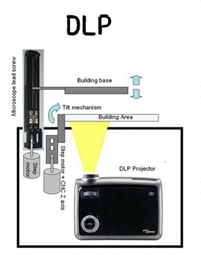DLP 3D Printing
DLP (Digital Light Processing) is a 3D printing technique that uses a video projector or LCD display to fix photopolymers. Very similar to SLA, this process differs by the use of a bulb or an LCD matrix in place of a UV laser beam.
A chip composed of a matrix of orientable mirrors - sometimes several million - reflects a UV light and projects a kind of image corresponding to the shape of the layer to be printed. This light is hitting the polymer in a tray to solidify it. The treatment is layer by layer, as in the case of ALS.
Objects printed with this technology have smoother surfaces, unlike other processes such as FDM / FFF. Compared to SLA, DLP is faster (and less expensive). Indeed, this process involves no displacement of the light on the horizontal axis (unlike the UV laser of the SLA process, which must scan the tank point by point to draw each slice of the object): only the platform to move gradually.
The principle is similar to stereolithography (SLA), in the sense that light is used to solidify a liquid polymer.
This process uses the same photopolymers as SLA. The objects printed by this process therefore have the same characteristics.
We use Zortrax and 3D system builders printers
Custom offer
Would you like a personalized offer on our products or any other information? Fill in this form. We will get back to you quickly with an offer.
Last edited: 24/11/2020
















